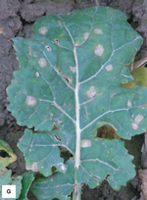Leptosphaeria maculans genome project

oilseed rape leaf infected
Leptosphaeria maculans 'brassicae' (Lmb) is the ascomycete fungus that causes "stem canker" (also termed "Blackleg") on oilseed rape, Brassica napus, and numerous other crucifers ( Rouxel et al. 2011 ). It is representative of an important genus of fungal phytopathogens, the Dothideomycetes, of which six other species have been, or are in the process of being, sequenced by US sequencing centers. The life cycle of Lmb is extremely complex and includes alternate phases of saprophytism on stem residues, necrotrophy on leaves, endophytism within plant tissues and necrotrophy at the basis of the stem. The disease is endemic in all oilseed rape-growing parts of the world and may cause 5-20% average yield losses due to lodging of the crop before harvest. Lmb develops gene-for-gene interactions with its host plants and is considered as a model to study specificity of interaction and adaptation to plant resistance gene selection pressure in agro-ecosystems ( Rouxel et al, 2005 , Gout et al 2007 ),.
Objectives
- Genome sequencing (2007) by Genoscope (45 Mb, 12x coverage, 41 supercontigs)
- cDNA sequencing 42000 ESTs (2007) Genoscope
- Structural annotation
- Gene prediction
- Transposable element annotation
- Genes functional annotation
- Transcriptomics
- Manual curation
- Comparative genomics
First genome facts
- Mitochondrial genome is 155 kb, which is significantly larger than that of other dothideomycetes.
- The current assembly is of high quality comprising 41 supercontigs with 50% of the genome in only 9 scaffolds bigger than 1.8 Mb. The mitochondrial genome and a probable minichromosome also occur as a single scaffold.
- The gene prediction pipeline has been processed through ab initio gene finding softwares and similarity methods. All results have been then gathered and processed by Eugene to predict 12469 gene models..
- In addition to preliminary studies on Lmb transposable elements (Attard et al, 2005) , a Transposable Element pipeline has been used for the detection (TEdenovo) and the annotation (TEannot) of transposable elements in L. maculans genome sequences and the families of repeats thus identified were manually expertised.
- Sequences & Databases access
Post-genomic approaches results
To validate the current assembly and facilitate further map-based cloning strategies, efforts are focused on the generation of a physical map linking the available genetic map and the genome sequence. The very high level of meiotic recombination within chromosomes necessitates that novel mini or microsatellite-type markers are generated for this purpose (Ecker et al, 2005).
Comparative genomics approaches are underway with the genome of Stagonospora nodorum (R. Oliver, Murdoch University, Australia) to evaluate gene conservation, synteny and repeated elements history. A Dothideomycete comparative platform is being set-up at the JGI (USA) and should enable expansion of these studies.
A specific focus is on the annotation and analysis of small-secreted proteins possibly acting as effectors ( Gout et al, 2006 , Fudal et al, 2007 ). Within the framework of the French Research Agency ANR -funded project FungEffector (led by M.H. Lebrun, INRA-Bioger), bioinformatics, transcriptomics and proteomics approaches are being developed for this purpose.